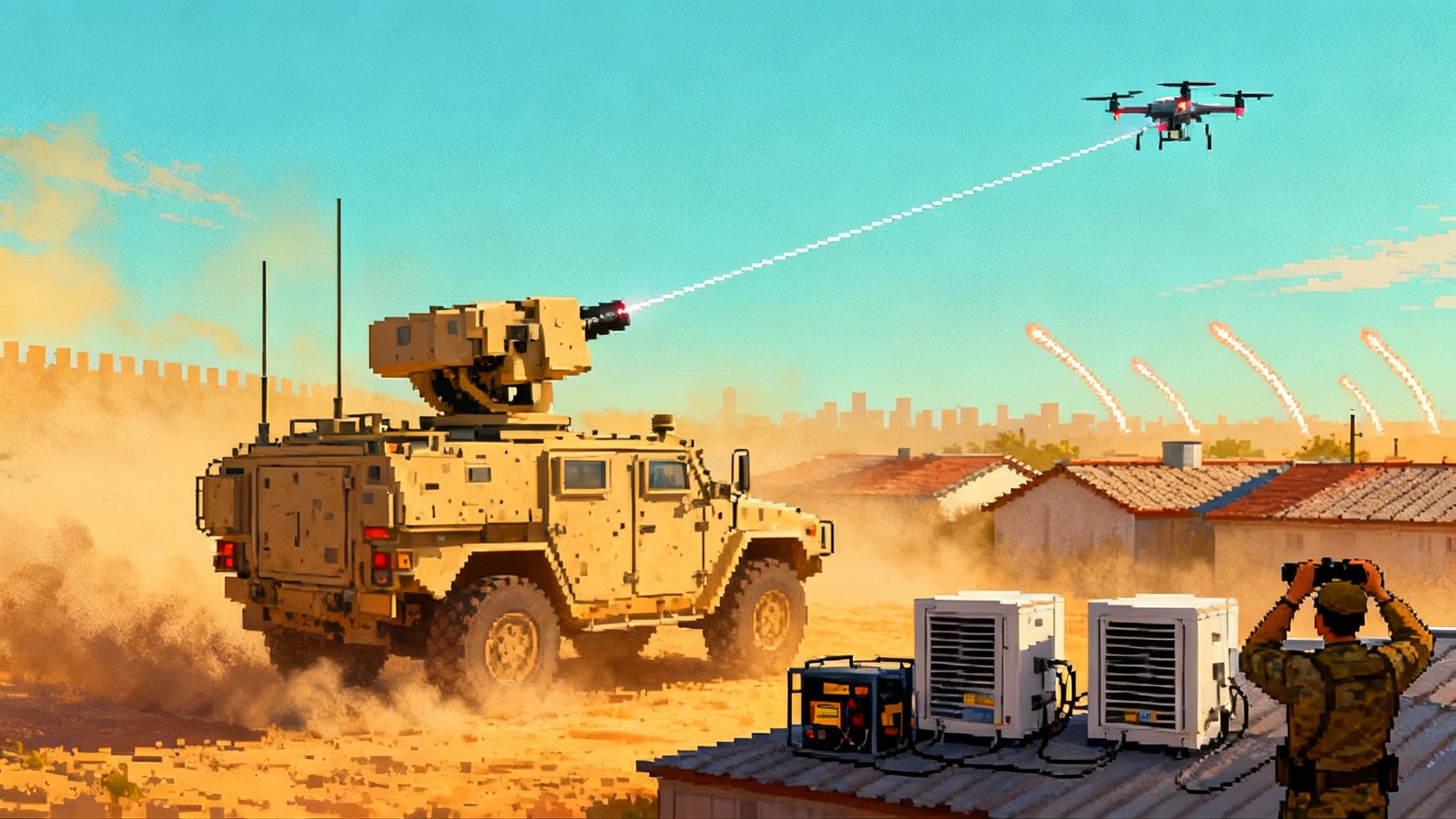2025: The Year Laser Air Defense Finally Went Live
Israel is bringing Iron Beam into service while China publicly rolled out LY‑1 and OW5 lasers. Together they signal a real shift in counter‑drone and rocket defense, where cost per shot, physics limits, countermeasures, and U.S. fielding plans collide.

The moment lasers stopped being a science project
Every revolution has a hinge year. For directed‑energy air defense, 2025 is when prototypes gave way to fielded systems and public debuts. Israel says its Iron Beam will enter operational service this year after full‑up trials, a first for a high‑power laser in national air defense, as reported by Reuters on Iron Beam fielding. Days earlier, China rolled its own laser weapons through Tiananmen Square, highlighting a ship‑capable LY‑1 and OW5 series aimed at counter‑drone defense, covered in Channel NewsAsia parade coverage.
Why it matters
A laser can flip the economics of the air and missile fight. If it works reliably enough, a fast, precise beam powered by diesel fuel or grid electricity can swat down low‑end threats that would otherwise drain magazines of expensive interceptors. Saturation drone attacks, cheap rockets, and mortar volleys are built to bleed money and missiles. Lasers are designed to bleed electricity instead.
What Israel is fielding
Iron Beam complements Iron Dome, David’s Sling, and Arrow with a short‑range, speed‑of‑light effector that promises negligible cost per engagement compared to a missile. The technical recipe is familiar across modern high‑energy laser programs: combine a high‑power laser source with precise beam control on a rugged mount; add sensors to detect and track small, fast targets; then dwell energy on a vulnerable point until the target fails.
- Small quadcopters: heat a motor or flight controller.
- Simple rockets: burn through a thin casing to destabilize flight.
- Larger drones: hold for several seconds on a wing spar or engine intake.
The value proposition is straightforward. In fights where adversaries launch dozens or hundreds of cheap aerial threats, a defender with a low‑cost, speed‑of‑light option gains breathing room. Lasers will not replace interceptors; they preserve interceptors for what only missiles can defeat.
What China just showed
On September 3, Beijing’s Victory Day parade included visible laser systems alongside missiles and drones. The LY‑1, a large unit analysts believe can be adapted for ship or shore, appeared with other anti‑drone capabilities. China also displayed OW5 variants aligned with land‑mobile counter‑drone missions. Public details remain scarce, but the optics of simultaneous Israeli fielding and Chinese showcasing signal that directed energy has entered the mainstream defense conversation.
The cost‑per‑shot revolution, in real numbers
Financial arithmetic in air defense is brutal. A single short‑range interceptor can cost tens of thousands of dollars, and medium‑range missiles can be far more. A laser shot consumes electricity and wear, which translates to a few dollars in fuel and maintenance per engagement. Even if a laser unit is expensive to buy, the marginal cost of stopping a cheap drone or rocket is dramatically lower. Over weeks of sustained attacks, that delta becomes decisive. For deeper background, see our real cost per engagement analysis.
Physics is still the boss: power, cooling, and air
Lasers trade chemical energy for photons, but thermodynamics still rules. Practical limits show up in four places:
- Power on target: Destructive energy at tactically relevant ranges demands tens of kilowatts for small drones and more for tougher targets. The system must generate, store, and deliver that power without voltage sag or thermal runaway.
- Beam quality and pointing: Tighter beams deliver damaging irradiance farther. Jitter, atmospheric distortion, or weak adaptive optics smear energy and extend dwell times.
- Cooling: High‑energy lasers are heat engines. Waste heat from the power source and the laser must be removed quickly with chillers and heat exchangers. Without robust cooling, shots per minute drop and components age faster.
- Atmospherics: Fog, rain, dust, smoke, and heat shimmer scatter and absorb energy. Clear, dry air is a laser’s best friend; coastal haze or urban dust storms are not.
These constraints explain why early fielding focuses on short‑range roles and smaller or simpler targets.
Rules of engagement and the human factor
Even when physics cooperates, lasers must obey rules, and so must their crews. Positive identification, airspace deconfliction, and aviation safety matter. Urban warfare adds obscurants and clutter that can hide adversaries and degrade beams. Tactically, crews will learn when to hold fire, when to pulse and test, and when to commit to a long dwell. Against a drone swarm, prioritization matters even more. See our counter‑UAS playbook for doctrine trends.
The countermeasures adversaries will try
Lasers are not magic. Expect a cat‑and‑mouse game similar to radar versus electronic attack.
- Obscurants: smoke, aerosols, and dust reduce effective range.
- Reflective or ablative coatings: delay heating and buy seconds.
- Fast spin or tumble: spreads energy and increases dwell time.
- Thermal hardening: insulates motors, batteries, and flight computers.
- Small cross sections and composite skins: fewer useful aimpoints.
- Saturation and timing: overwhelm engagement rate and cooling cycles.
- Angle games: oblique aspects reduce energy coupling.
Lasers remain part of a combined arms defense with jammers, guns, missiles, and deception.
How armies will use lasers in 2025 and 2026
Commanders will treat lasers as magazine extenders and niche problem solvers inside layered defenses:
- Detect and sort: Radars and passive sensors classify threats. Small drones and unguided rockets go to a laser or gun queue; larger and faster threats go to missiles.
- Engage at lowest effective cost: If air and geometry are favorable, the laser shoots first; if not, hand off to guns or missiles.
- Protect critical nodes: Position lasers where saving missiles matters most, with clear sightlines and minimal obscurants.
- Keep them powered and cool: Generators, grid taps, and cooling fluids become as important as missile resupply.
- Train for the human loop: Operators learn aimpoint selection, dwell management, and timing across layers.
The U.S. path: DE M‑SHORAD and beyond
The U.S. Army’s Directed Energy Maneuver Short‑Range Air Defense on Stryker has matured through multiple soldier touchpoints and live‑fire events. Current 50 kW‑class systems target Group 1 to Group 3 drones, rockets, artillery, and mortars at short ranges. The near‑term objective is translating prototypes and urgent experimentation into repeatable units with reliable power, cooling, and software, then transitioning to a program of record. For context on the kinetic layer it complements, read our M‑SHORAD explained article.
On the water, the U.S. Navy has pursued shipboard lasers and dazzlers to protect surface combatants from drones and small boats. Trials over recent years show lasers can disrupt or defeat simple threats and augment close‑in weapons. Next steps focus on reliability at sea, integration with combat systems, and scaling power without crippling electrical margins.
In the air, lasers are inching toward pods that can blind or degrade incoming missiles or damage small drones. Airborne platforms benefit from clear lines of sight but face harsh weight and power limits. Early missions emphasize self‑protection and counter‑UAS around high‑value assets.
Allies are not waiting on the sidelines
Britain has advanced DragonFire and is pivoting from demonstrations to ship and site applications. Germany demonstrated a naval laser on a frigate and continues land work with industry partners. Italy, France, and the Netherlands are exploring laser roles within close‑in defense layers. Japan and South Korea are investing in counter‑drone lasers tailored to their concepts and industrial bases. Australia is funding research that emphasizes expeditionary power and modularity.
What lasers are already good at, and what they are not
- Good today: small drones at short ranges, especially in clear air; unguided rockets and mortars with thin skins; sensor dazzling against unprotected optics.
- Acceptable with caveats: medium drones or loitering munitions with modest hardening, given favorable weather and geometry.
- Not yet the job: maneuvering cruise missiles in cluttered air, supersonic rockets with robust casings, or high‑G ballistic threats.
How attackers will escalate, and how defenders will respond
Attackers will push toward quantity, complexity, and mixed salvos. Picture a smoke‑covered approach where low‑cost drones arrive with simple reflective shields, followed seconds later by hardened drones and a stray rocket or two. The aim is to break engagement sequences, overload cooling cycles, and force a missile shot.
Defenders will counter with automation and prioritization. Better sensors and AI‑assisted tracking will shorten aimpoint discovery and reduce dwell. Multi‑beam architectures will enable two or more simultaneous engagements per unit. Power and cooling upgrades will increase sustained shots per minute. Lasers will not act alone. Jammers will drop control links, guns will finish what lasers start, and missiles will handle what only missiles can stop.
What to watch next
- Availability, not just capability: How many hours per day can a unit fight before cooling or maintenance pauses? How many clean shots per hour in haze or drizzle?
- Real cost per engagement: Tally fuel, maintenance, manpower, and depreciation. If a laser neutralizes dozens of drones for the price of one missile, procurement will accelerate.
- Integration with kinetic layers: The smoother the handoff, the greater the system’s capacity against mixed raids.
- Counter‑countermeasures: Coatings, spins, and smokes that worked once will fade as beam power and aimpoint analytics improve.
- Industrial scaling: Can industry deliver enough beam directors, chillers, and power modules without bespoke bottlenecks?
The bottom line
2025 did not make lasers the only answer. It made them a practical answer. Israel’s decision to bring Iron Beam into service and China’s choice to parade LY‑1 and OW5 tell the same story from different angles. The age of treating lasers as a forever future is ending. The fight to make them routine, reliable, and resilient has begun.
For commanders facing relentless drone and rocket harassment, that shift is more than a headline. It is the start of an economic and tactical rebalancing, where the defender’s cheapest shot can finally be the one that comes at the speed of light.








